
Welcome to Pain 101
Many people who come for treatment at the Multidisciplinary Pain Centre live a long way from the hospital. They spend many hours driving back and forth for appointments and treatments. In many ways, their experience can be very different from the people who live near the hospital.
While we hope that everyone will benefit from Pain 101, we hope that it will be especially helpful for people who live far from the hospital.
If you have comments or questions about Pain 101 or the website,
please email us at Pain101@ualberta.ca.
What is Pain 101?
Pain 101 is a program that was created by health professionals at the
University of Alberta and the Multidisciplinary Pain Centre at the
University of Alberta’s Edmonton Clinic South in Edmonton, Alberta.
Many of the methods and materials are based on a world class chronic
pain management program developed at the Royal National Hospital for
Rheumatic Diseases in Bath, UK.
The pain management strategies used in Pain 101 have been learned from experts around the world. The idea came from a program called the Family Help Program, developed by Dr Patrick McGrath and his colleagues in Halifax, Nova Scotia, Canada. The chapters of this program were chosen based on feedback we have received from hundreds of our patients.
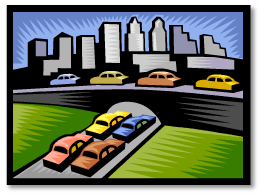
About the Chapters
Pain 101 is made up of 10 chapters. Each chapter talks about strategies
you can use to help solve problems related to chronic pain. There are
worksheets for each of the sections in every chapter, which are there to
help express the concerns you may have in your life. If you have a coach,
he/she will go through your answers with you over the phone to help
guide you with your plan.
For each chapter, there is an example of how a person living with chronic
pain has used all of the Pain 101 steps to help solve the problem they
chose to work on. There are also videos showing examples of individuals
using problem-solving strategies in their own lives.
Below is a complete list of the Pain 101 chapters (there is always quick access to these chapters from the menu on the left). Please start by reading the Introduction. Also note that the chapters don’t have to be read in order. We encourage you to start with the ones that interest or affect you the most.
• Pain Education – Learning About Chronic Pain
• Pain & Tension – Dealing with Tension Using Relaxation
• Pacing – Setting Activity Goals
• Mood – Dealing with Depression and Negative Thoughts
• Sleep – Improving Your Sleep
• Stress – Dealing with Stress
• Communication – Communicating and Pain Behaviour
• Setbacks – Dealing with Pain Flares and Bad Days
• Life with Pain – Living With Pain

Navigating the Site
1. Accessing the Chapters
The easiest way to go to the chapter list is to click the Chapters
button at the very top of the page OR hover over 'Chapters' and a
drop down menu will appear with a list of the chapters. To select a
Chapter simply hover over the desired chapter and click.
2. Turning the pages.
Each Chapter is made up of pages, which consists of the Chapter's table of contents (aka. navigation bar - left) and the main reading content. To move between pages simply click the title, in the navigation bar, you wish to read.
Some pages (ie. PACE) have hidden content within a drop down menu. To read these, click the drop down menu title and it will automatically open.
3. Where am I?
If you are ever unsure about where you are, you can look at the navigation information underneath the chapter title.
4. Adobe Reader
There are a number of places on the website where you will be asked to click on a button or an icon in order to bring up a document. In order to view these documents you will need to have Adobe Reader installed on your computer. If you don't have Adobe Reader on your computer you can download it for free at http://get.adobe.com/reader/.
If you are unsure whether you have Adobe Reader, click here, if you clicked the link and a document opens showing you a happy face and a thumbs up, you already have Adobe Reader on your computer and you do not need to install it.
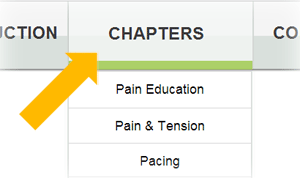

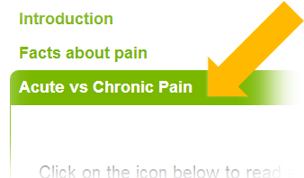
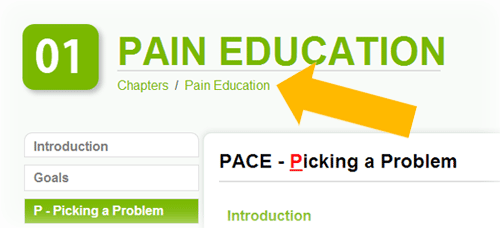
Frequently Asked Questions (FAQ)
Q: How will Pain 101 help me?
A: There is research that shows individuals who learn to problem-solve when
they are diagnosed with a chronic health problem do better in a number of ways.
They feel more positive and less depressed; they feel less stressed and better
able to cope and do better emotionally and physically.
Q: Do I need to work on the chapters in a specific order?
A: Everyone who chooses to participate in Pain 101 starts with the Introduction
chapter. We try to leave it up to each person to decide which order they do the
rest of the chapters in. Your coach can also help with this decision if you wish.
However, in general we recommend that some chapters be completed before
other so that you can learn some skills that will help you complete later chapters
more effectively.
Q: How long does each chapter take to completed?
A: Programs like Pain 101 have been found to the most helpful for people
when the chapters and videos are finished in a fairly short amount of time.
Each chapter takes about 90 minutes to complete.
We encourage people to complete one chapter each week. It is up to you
whether you want to work through the chapter all at one time or spread it
out over a few days.
People who watch the videos and actively work on the chapter activities are most likely to benefit from this program.
Q: When and where should I use PACE?
A: It can be hard for people in a busy home to find time to
sit and think about problems without being interrupted.
However, when using PACE, you must give yourself
enough time to really focus on the problem you are trying
to solve
• Make a point of setting time aside
• Talk to your coach if you are having troubles finding time to work on PACE
Q: Is this just another book to read?
A: Many of our patients have gathered a lot of information about chronic pain over the years. Some people tell us they feel overwhelmed by the amount of reading that they need to do to understand what is happening to them. You may feel like you have learned a lot but aren’t sure of the best way to use all of this information.
Pain 101 is different because it gives you information that you need but also helps you develop skills that you can use in any areas of your life. It does this by teaching a problem solving approach (PACE) to collecting and using information to solve problems related to chronic pain.
Pain 101 involves reading a website, looking at videos, and completing worksheets. You are encouraged to actively work on each chapter. For most, making this effort increases the changes that you will really learn the information and be better able to use it in everyday life.
Each chapter begins with a table of contents so you can find the information you want quickly, and ends with a list of resources such as books, websites, and videos that you might find helpful.
Q: How do I begin?
A: Now that you have read about the Pain 101 program, you may begin
reading the rest of the chapters. Remember that every chapter is a step
toward improving your quality of life. It will take effect to complete the
chapters but it is not intended to feel like homework.
The best way to get the maximum benefit from taking part in this program
is to follow the suggested steps and practice them regularly. Your coach
looks forward to speaking with you and helping you through this journey
towards a better quality of life. Happy reading!
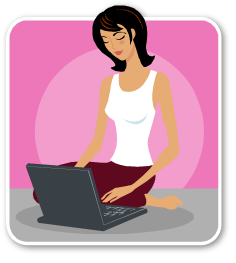
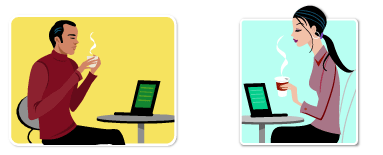

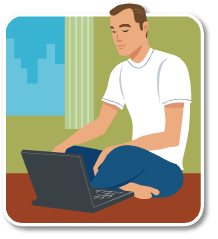


Introduction to PACE
All of the chapters in PAIN 101 are organized in a specific way. They all follow the same problem-solving approach called PACE. Each of the letters in PACE stands for a problem solving step.
Click on the icon to see a video about PACE
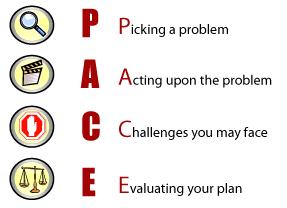

– Acting upon the problem
Okay, you’ve done the research. Now it is time to take action!
• How do you plan on solving your main concern?? Which of the suggestions seem practical?
• Who else needs to help develop the plan?
• Decide when is the best time to start taking action against the problem
Pain 101 helps by:
• Showing you many ways to solve a problem. The Act section is often the longest. Videos will help you work on skills that can help solve the problem like learning how to relax
– Evaluating your plan
Just like using a scale, weigh out how successful the plan was in dealing with your problem
• How well is your plan working? Are there things you need to change or adjust?
• Was the problem you worked on the main problem? Is it time for detective work?
Pain 101 helps by:
• Providing a coach who will help you evaluate the success of your plan. Your coach will also give you credit and encouragement when you use a helpful strategy to solve a problem
• Your coach can also help you come up with ideas on how to follow through with your plan in your everyday life
Click on the video for more on
evaluating your plan
– Picking a problem
Take some time to play detective or ask someone you trust to help.
• Set aside “quiet, alone” time to think
• Come up with one problem that needs to be solved
Pain 101 helps by:
• Providing a list of common problems
• Your coach can help you narrow it down to one problem to start with
– Challenges you may face
Even wonderful plans can have obstacles that may stop your plan temporarily
• What might get in the way of your plan?
• Can you avoid these challenges or develop a strategy to deal with them?
Pain 101 helps by:
• Outlining in each chapter common challenges chronic pain patients have experienced
• The coach will help you brainstorm possible barriers, ways to prevent them and how to cope with them if they do happen
Click on the video icon to learn more
about challenges you may face.
In each chapter the PACE sections have their own index.

Word
Definition
Pain 101
A program designed to help improve the quality of life of individuals with chronic pain. It offers reading material, videos, and worksheets.
Care Team:
PACE
A large group of people who all work together and do everything they can to help a person manage their pain and live a fuller life. The patient is the central member of this team.
Each letter stands for a useful step in problem-solving:
Picking a problem
Acting upon the problem
Challenges you may face
Evaluating your plan
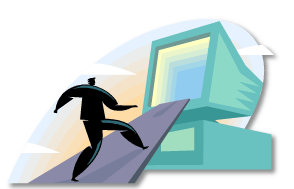
Welcome to Pain 101
This brings us to the end of the Introduction. You are now ready to begin
reading the Pain 101 chapters. You can read the chapters in any order you
wish. We encourage you to start with those what will benefit you the most.
Clicking on the Next button will bring you to the table of contents for the
chapter called Pain Education. However you if you want to read a
different, click on the 'Chapter' button in the menu (top) and
select the desired chapter.
Introduction
What is Pain 101?
About the Chapters
Navigating the Site
FAQ's
Introduction to PACE
Glossary
Conclusion






